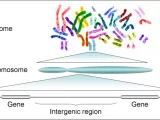
Step-by-Step Guide to Calculate Coverage in Genomic Sequencing
December 28, 2024Introduction to Coverage Calculation
Coverage, in the context of genome sequencing, refers to how many times a particular base or region of the genome is sequenced. It is crucial for determining the quality of the sequencing process, including how well the genome is represented and the likelihood of missing critical genetic variants. Coverage is particularly important in applications like variant calling, genome assembly, and metagenomics, where accuracy depends on reliable and comprehensive sequencing data.
1. Understanding Coverage Calculation Formula
The basic formula for calculating genome coverage is:
Coverage=(Read Count×Read Length)Genome Size\text{Coverage} = \frac{(\text{Read Count} \times \text{Read Length})}{\text{Genome Size}}
Where:
- Read Count is the total number of reads in the FASTQ file (this can be determined using
wc -l). - Read Length is the length of a single read (e.g., 250 bp in the case of Illumina sequencing).
- Genome Size is the total length of the genome being sequenced (e.g., 5.2 million bp for the E. coli genome).
2. Step 1: Get Read Count from the FASTQ Files
A FASTQ file contains raw sequencing data, with each read spanning four lines. To calculate the number of reads in the FASTQ file, you can use the wc -l command in Unix. This counts the number of lines in the file, but since every read spans four lines, you need to divide the total by 4:
Let’s assume the output is 2000000. The number of reads would be:
Read Count=20000004=500000 reads\text{Read Count} = \frac{2000000}{4} = 500000 \text{ reads}
3. Step 2: Identify Read Length
For Illumina sequencing, the read length is typically given (in this case, 250 base pairs). This can be checked or confirmed by looking at the sequencing platform specifications or reading the FASTQ file header if necessary.
4. Step 3: Know the Genome Size
The genome size is often provided in the study metadata. For example, for E. coli, it is approximately 5.2 million base pairs (5.2 Mbp). This information is typically available in genome references or can be obtained from the literature.
5. Step 4: Calculate Coverage
Now that you have the values for Read Count, Read Length, and Genome Size, you can calculate coverage.
Coverage=(500000×250)5200000=24×\text{Coverage} = \frac{(500000 \times 250)}{5200000} = 24 \times
This means that, on average, each base in the genome will be covered 24 times by the sequencing reads.
6. Step 5: Align the Reads to the Genome (Recommended for Accuracy)
While the formula above gives you an idealized average coverage, real-world factors (like low-quality reads or non-alignable regions) can affect the actual coverage. To get a more accurate estimate, you should perform read alignment using tools like SMALT or BWA to align the sequencing reads to a reference genome.
Example alignment command (using BWA):
7. Step 6: Convert SAM to BAM and Sort
Once the reads are aligned, convert the SAM file to a BAM file (a binary version of SAM) and sort it to prepare for coverage analysis.
8. Step 7: Calculate Coverage from BAM File
The most reliable way to calculate coverage from aligned reads is using Depth of Coverage tools such as GATK or BEDTools. These tools can calculate the actual number of aligned bases at each position in the genome.
For example, using GATK:
This will provide a detailed output of coverage per base across the genome.
9. Optional: Plot Coverage
You can also visualize the coverage data to see how evenly the genome is covered. Tools like BEDTools and R can be used to create coverage plots.
Example with BEDTools:
You can then plot this data using R or other visualization tools.
10. Importance of Coverage Calculation
Coverage is essential for understanding the quality and completeness of sequencing. Low coverage can lead to missing variants or incomplete genomes, while excessively high coverage may indicate redundancy and wasted resources. Ensuring adequate coverage is vital for downstream applications such as:
- Variant Calling: Low coverage can result in false negatives, where real variants are missed.
- Genome Assembly: Insufficient coverage might prevent successful assembly of the genome.
- Metagenomics: In shotgun metagenomics, adequate coverage ensures all species in the sample are represented.
11. Conclusion
While calculating coverage using the basic formula gives an initial estimate, aligning reads to the genome and using specialized tools like GATK or BEDTools is crucial for obtaining accurate coverage data. This approach accounts for real-world issues like poor-quality reads and incomplete alignments.
Example Perl Script for Coverage Calculation
If you’d like to calculate coverage directly from the FASTQ file using Perl, you can use this script:
This script calculates coverage based on the read count from a FASTQ file and a known genome size.

















